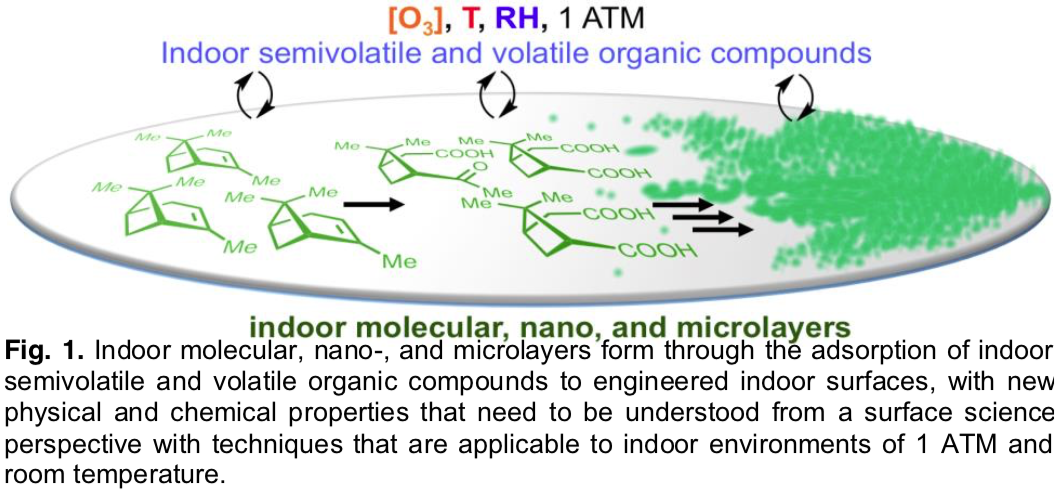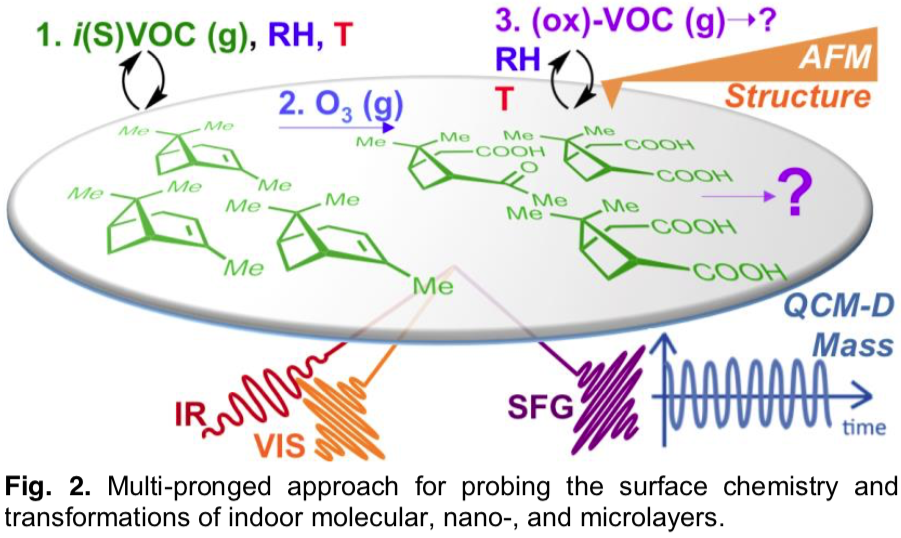While we take clean indoor air for granted, research shows that indoor air can be more polluted than outdoor air, with links now emerging to human health impacts like chronic fatigue, asthma, and sick building syndrome. Yet, mechanistic insights connecting health outcomes with indoor chemistry remain enigmatic, making fundamental studies on this topic a frontier in environmental and health science. We’ve been here before: just like fundamental science led to actions closing the ozone hole, fundamental studies of indoor chemistry hold the promise of improving indoor air quality. The high surface area:volume ratio typical for indoor environments makes interfacial chemistry particularly important, given that the surface of, say, a table, wall, carpet, or cupboard is the first entity encountered by incoming gas phase species, be they pollutants or benign constituents in air. The subsequent surface-mediated transformations are only poorly understood, largely because the interfaces involved are notoriously difficult to access at ambient pressure and temperature when using standard surface science techniques.

The present project aims to bridge this capability gap through advanced instrumentation and collaborative efforts that will contribute new chemical and physical knowledge about indoor surface chemistry. Mechanistic studies of idealized model surfaces as well as work on surfaces of samples derived from real-world indoor environments, including actual homes, will help us better quantify sources and sinks of indoor air pollutants, improve the prediction of dynamic changes in indoor air chemistry, and open the door for the design of smart coatings or paints for controlling, mitigating, or preventing negative outcomes of indoor air chemistry. To this end, we will conduct vibrational sum frequency generation spectroscopy experiments aimed at understanding, at 1 ATM, 5% to 95% RH, and room temperature, how minute amounts of surface-bound species slowly convert from molecular layers and “Gibbs monolayers” into nano- and microlayers, and how such transformations influence their respective physical and reactive properties (Fig. 1and 2). We will tackle this complex problem by pairing the experimental research activities at Northwestern University with ongoing research efforts on indoor air chemistry in the Grassian laboratories at UCSD. Moreover, we propose to work closely with The Modeling Consortium for Chemistry of Indoor Environments (MOCCIE) team so as to integrate state-of-the-art ambient surface, thin film, and bulk spectroscopy and analytics with advanced multi-scale (atomistic to macroscopic) computer modeling.
Our multi-pronged interdisciplinary approach will enable us to seek answers for the following 4 questions:
- What functional groups present themselves to incoming gas phase species (molecules to aerosol particles) on the surfaces of indoor molecular, nano-, and microlayers?
- How do the molecular orientation distributions and ensuing polarity at indoor molecular, nano-, and microlayers vary with changing RH and temperature?
- Under what conditions of RH and temperature do indoor semi-volatile organic compounds interact with indoor molecular, nano-, and microlayers reversibly or irreversibly, and what are the associated mechanisms?
- How does heterogeneous processing of indoor molecular, nano-, and microlayers by indoor oxidants (ozone) influence surface polarity, chemical exchange, and subsequently modified reactivity of the indoor molecular, nano-, and microlayers?
We will obtain adsorption, desorption, and ozonolysis rate constants of mono- and sub-monolayers of common indoor air constituents, quantify differences in heterogeneous reactivity towards ozone under dry vs humid conditions, provide molecular orientation angles and distributions associated with specific functional groups, and probe the surface chemistry of molecular, nano-, and microlayers derived in real indoor environments. Outcomes from this project will help us to better quantify sources and sinks of indoor air pollutants, improve the prediction of dynamic changes in indoor air chemistry, and open the door for the design of coatings or paints that control, prevent, or mitigate the buildup of indoor molecular, nano, and microlayers where needed.